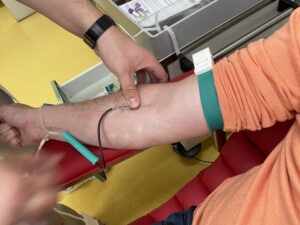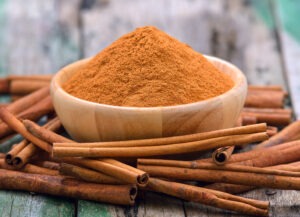Everyone needs to eat carbohydrates, but that doesn’t mean you should fuel up with cookies, candy, and potato chips. Learn about the best foods to reach for — and the ones to skip.

Cake and beans are both sources of carbs, but they are far from equal in quality.
Carbohydrates are an essential part of a healthy diet, but it’s important to know they’re not all created equal. How do you tell the difference between “good carbs” and “bad carbs”? The answer is both simple — and complex.
Here’s everything you need to know about making smart carbohydrate choices.
A Carbohydrate Can Be a Simple Carb or a Complex Carb
Carbohydrates often referred to as just “carbs,” are your body’s primary energy source, according to MedlinePlus. The three main types of carbohydrates are sugars, starches, and fiber. They’re called “simple” or “complex” on the basis of their chemical makeup and what your body does with them. Because many foods contain one or more types of carbohydrates, it can be tricky to understand what’s healthy for you and what’s not.
Simple carbohydrates are composed of easy-to-digest sugars, according to the American Heart Association (AHA). Some of these sugars are naturally occurring, such as those in fruits and in milk, while refined or processed sugars are usually added to foods like candies, baked goods, and soda. These simple carbs are quickly absorbed through the gut and can cause a spike in blood sugar levels, says Alicia Galvin, RD, the resident dietitian for Sovereign Laboratories in Dallas. On nutrition labels, added sugars can go by several different names, including brown sugar, corn sweetener, corn syrup, fructose, glucose, maltose, malt syrup, sucrose, honey, agave nectar, molasses, and fruit juice concentrates, according to Harvard Health Publishing. The U.S. Food and Drug Administration (FDA) now requires all nutrition labels to clearly identify the number of added sugars per serving in the product, directly beneath the total sugar count.
Then there are complex carbohydrates, which are found in whole grains, legumes, and vegetables, and contain longer chains of sugar molecules.
“Complex carbs have an additional component — fiber, which is technically a type of carbohydrate, but it’s not digested and absorbed,” Galvin says. “That not only feeds the good gut bacteria, but it also allows for the absorption of the carbohydrate to be slower into the bloodstream, so it won’t spike glucose levels and insulin levels like a simple carbohydrate would.”
This in turn provides you with a more consistent amount of energy, says Sandra Meyerowitz, MPH, RD, a nutritionist, and owner of Nutrition Works in Louisville, Kentucky.
The Details on Simple Carbohydrates
Foods that contain simple carbohydrates aren’t necessarily bad — it depends on the food. For instance, fruits and dairy products contain some simple carbs, but they are drastically different from other foods that contain simple carbs, like cookies and cakes. Processed sweets tend to contain refined sugar, too, and lack key nutrients your body needs to be healthy, according to the AHA.
“There are health benefits to eating fruit versus eating a piece of white bread,” Galvin says. “Fruit does contain fiber, and also antioxidants and polyphenols and other good nutritional benefits.”
Dairy also contains healthy nutrients, such as calcium, protein, and sometimes probiotics (if live active cultures are present), Galvin says. The protein component is key to helping dairy behave more like a complex carbohydrate. “Protein helps slow the absorption of carbohydrates into the bloodstream and helps keep appetite levels steady so you don’t have swings of insulin levels and blood glucose going up and down,” Galvin says.
Simple carbohydrates to limit or eliminate in your diet include those found in Soda, Candy, Desserts, Processed foods such as potato chips, granola bars, and crackers
Galvin says that in general, you don’t want to overdo your fruit intake, either. “You still have to be careful with fruit, because it is going to be more rapidly absorbed than something like sweet potatoes or beans that are very high in fiber,” she says.
Dr. Meyerowitz says that you can enjoy simple carbohydrates on occasion — you just don’t want them to be your primary source of carbs.
The Details on Complex Carbohydrates
Complex carbohydrates are considered “good” because of the longer molecules of sugars they are made of, which the body takes longer to break down, according to the Cleveland Clinic. That means the glucose will be released at a more consistent rate — instead of peaks and valleys — to keep you going throughout the day.
Foods with complex carbohydrates also typically have more important nutrients, including fiber and B vitamins, than foods containing more simple carbohydrates — as long as you’re choosing whole grains over processed ones, says the Mayo Clinic. For example, whole grains, such as whole-wheat flour, bulgur, brown rice, oatmeal, and whole cornmeal provide more nutrients than processed grains, such as white rice and breads or baked goods made with white flour, according to the U.S. Department of Agriculture (USDA).
As an example, take a look at how the nutrients in white bread compare with those found in whole-wheat bread, both from the brand Pepperidge Farm. Whole-wheat bread has fewer carbohydrates and more fiber, plus more potassium and folate.
White Bread
- 130 calories
- 4 grams (g) of protein
- 1 g fat
- 26 g carbs
- 1 g fiber
- 4 g total sugars
- 230 milligrams (mg) sodium
- 40 mg calcium
- 7 mg iron
- 50 mg potassium
- .2 mg thiamin
- .1 mg riboflavin
- 5 mg niacin
- 95 micrograms (mcg) folate
100 Percent Whole-Wheat Bread
- 130 calories
- 5 g protein
- 5 g fat
- 23 g carbs
- 4 g fiber
- 4 g total sugars
- 180 mg sodium
- 40 mg calcium
- 3 mg iron
- 125 mg potassium
- .1 mg thiamin
- .1 mg riboflavin
- 2 mg niacin
- 10 mcg folate
According to the Physicians Committee for Responsible Medicine, nutrient-dense complex carbs to seek out for a healthy, balanced diet include:
- 100 percent whole-wheat breads
- Barley
- Quinoa
- Potatoes
- Oatmeal
- Beans
It’s important to scan ingredient labels for foods like breads and pastas, looking for whole grains and fewer sources of added sugar. “Read the box so you know what exactly you’re getting,” says Meyerowitz.
When trying to figure out if a source of carbohydrates is good or bad, remember this: “If you see anything like cane sugar, honey, molasses, maple sugar, even coconut sugar or agave — any of those added sugars anywhere in the first three or four ingredients — you want to put it back on the shelf,” Galvin says. These ingredients indicate the item is high in added sugars.
Instead, look for ingredients like whole-grain wheat flour, whole-grain oats, whole-grain quinoa, and the like. Those are examples of healthy complex carbs that contain more fiber, Galvin says. And don’t be fooled by “wheat bread.” “Wheat bread is just a fancy name for white bread,” Galvin says.
The Glycemic Load Factor
Simple or complex is one way to classify carbs, but nutritionists and dietitians now use another concept to guide people in making decisions about the carbs they choose to eat.
The glycemic index (GI) of a food indicates how quickly your blood sugar will rise after you eat that food, on a scale of 0 to 100, according to Better Health. Foods with a high GI (higher than 70) are easily digested and cause a quick rise in blood sugar. Foods with a low GI (lower than 55) get digested more slowly and the blood sugar response is flatter.
Knowing the GI for a specific food can help you understand how the carbs in that food will affect your blood sugar, but it’s important to point out that it doesn’t necessarily make a food unhealthy or healthy. According to the University of Sydney’s online international GI database, fruits like watermelon and cantaloupe both have a high GI, 72 and 70 respectively, but they are both healthy foods.
To take this approach one step further, you want to look at the glycemic load of a food. The glycemic load factors in both the glycemic index and how much carbohydrate are in the food, according to the University of Oregon. To determine glycemic load, you multiply a food’s glycemic index number by the amount of carbohydrate the food contains per serving, and divide by 100.
A low GL is 10 or less; medium is 11 to 19; and 20 or greater is considered high, per the University of Oregon. A food can be considered high on the GI scale and low in terms of GL. For example, a banana has a GI of 55 and a GL of 13, according to the University of Oregon. Even if a food contains carbs that have a high GI, if the amount of carbohydrates is low then it won’t have as much of an impact. Another good example is watermelon, which has a high GI of 76 but a low GL of only 8, because it contains 11 g of carbohydrates per serving, according to the University of Oregon.
“Overall, glycemic load is going to be a better rating system than glycemic index because GI does not take into account the serving size,” Galvin says.
What to Know About Net Carbs
Net carbs are another piece of the carbohydrate conversation. According to the Mayo Clinic, net carbs refers to the number of carbohydrates in a food minus fiber (though this term is not regulated by the FDA, so that definition may not be used by every food company and some may also subtract sugar alcohols). Because fiber does not significantly raise the body’s blood sugar levels, it can be taken out of the food’s total carb count to determine net carbs, according to the University of California in San Francisco (UCSF). For example, if a food contains 10 g of carbs, including 5 g of fiber, then it contains 5 g of net carbs.
Tracking net carbs is the foundation of some low-carb eating plans, such as Atkins or the Keto diet. But if you’re not following those diets, it’s probably not a helpful thing to track, Galvin says. “You don’t necessarily have to worry about subtracting the fiber from the carbs if you’re just following a generally healthy diet,” she says. Galvin says you should, however, still aim to reach the recommended fiber intake, which is 28 g per day, according to the USDA.
The bottom line: Carbs are not bad for you. Carbohydrates — both simple and complex ones — are part of a healthy diet. Just be sensible about the carbs you choose. Skip low-nutrient desserts, consider the levels of sugar and fiber, and focus on healthy whole grains, fruits, and veggies to get the energy your body needs every day.
Tips for Making Healthy Carb Choices
The following resources and tools can help you discern good carbs from bad carbs.
- Get food-label savvy.
- Visit the USDA site for an in-depth explainer on how to read food labels.
- Learn to make substitutions.
- Check out this website from Harvard Health Publishing for ways to substitute good carbs for bad ones.
- Bookmark handy websites.
- Brush up on your general carb knowledge. Quiz yourself on your carb knowledge through the UCSF site.





































